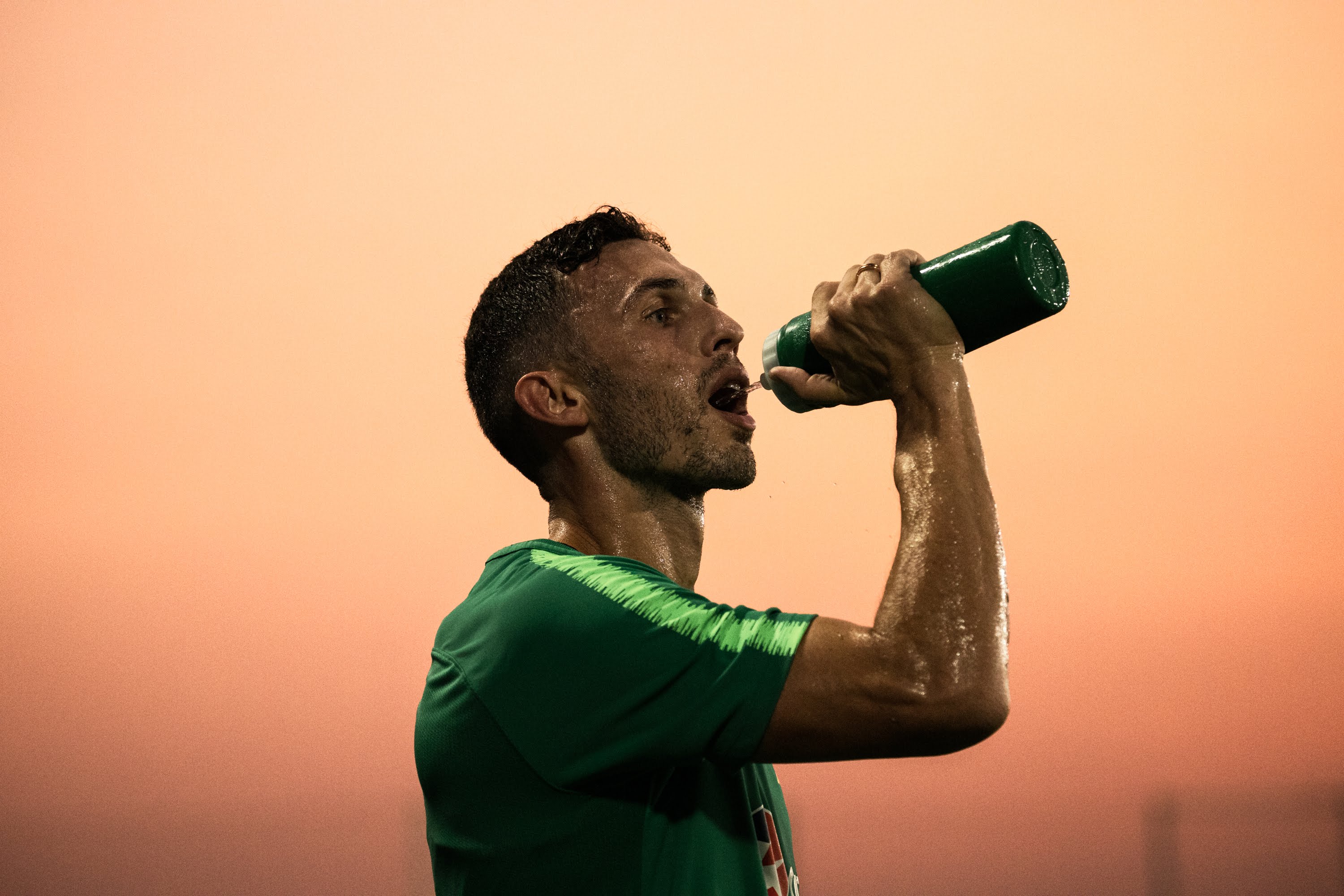EXTREME ENVIRONMENTS
Qualifying through the Asian Football Confederation exposes Australia’s national teams to the extreme heat and humidity of the Middle East and Southeast Asia, extreme cold of northern China and the Korean peninsula and the altitudes of the Himalayan region. On home soil, footballers at all levels are often exposed to similarly challenging environmental conditions.
Understanding and planning for upcoming environmental challenges can help you prevent many of the associated performance and health problems.

Select the dropdowns below to learn more about some of the extreme environmental challenges players face and how to combat them.
|
Our bodies operate most efficiently in a narrow temperature band around approximately 37°C [1]. Exposing players, coaches or spectators to extreme heat and humidity can elevate their bodies’ core temperatures dangerously, placing them at an elevated risk of hyperthermia or heat illness [2, 3]. Playing football requires a lot of energy and metabolising this energy in our muscles generates heat. Our bodies’ cooling strategies work efficiently to reduce this heat when playing football in temperate environments. However, they don’t work anywhere near as efficiently in hot and humid conditions, potentially leading to elevated body temperature of 40 degrees Celsius or higher [1]. Use the following strategies to reduce heat stress when playing football:
Football Australia’s heat policy defines guidelines concerning environmental temperature management using the Wet Bulb Globe Temperature (WBGT) and the management of drink/cooling breaks during a match. |
Whilst not as common in Australia as heat illness, prolonged cold exposure during football matches or training can still lead to hypothermia. Knowing the potential risks and understanding strategies to combat the cold ensures that your performance and safety is prioritised.
Cold air, wind and wet clothing can all have significant cooling effects, despite our bodies best efforts to preserve heat by restricting blood flow to our skin surface and increasing energy metabolism (for example by shivering) [2]. Try to prepare for playing in cold, wet and windy conditions by:
- keeping active on the pitch
- layering your clothing
- taking shelter during rest periods
- maintaining your hydration levels, despite possible reduced thirst, as our bodies continually produce heat and perspire, even in cold conditions
Parents and coaches should be aware of the risks of extreme cold exposure and its potential impact on other health related issues, such as asthma or other respiratory problems [2].
Australian footballers rarely compete at altitudes significantly above sea-level. However, both Socceroos and Matildas have played China in Kunming, at nearly 1900 metres above sea-level, while the 2022 WC Qualifying campaign intended for the Socceroos to play Nepal in Kathmandu.
In general, the effects of altitude on football performance increase the higher up a match takes place [2]. Big footballing nations like Brazil and Argentina repeatedly losing to Bolivia in La Paz (3640 metres above sea-level) even moved FIFA to temporarily suspend all international matches played above 2500 metres in altitude (this suspension has since been revoked).
Altitudes below 2000 metres are generally considered safe but can still cause mild to moderate performance decrements [2]. These are best explained by the lower air pressure making it harder for our bodies to consume oxygen, which in turn decreases our endurance capacity [2]. Lower air pressure also affects the flight of the ball, which makes it harder for goalkeepers to make saves or for strikers to anticipate the arrival of a cross [4].
As with competing in the heat, acclimatising to environmental conditions at altitude well in advance of playing a match is the most effective way for you to combat any potential negative effects [2].
Suggested Reading
- Football Australia’s heat policy covers all Australian football – from A-League and W-League to grassroots.
- Clearinghouse for Sport is a fantastic free resource for all things sports related. They discuss heat illness in more detail.
References
- C. May, “clearinghouseforsport.gov.au,” Clearinghouse for Sport, 30 January 2020. [Online]. Available here. [Accessed 22 July 2020].
- M. Bergeron, R. Bahr, P. Bärtsch, L. Bourdon, J. Calbet, K. Carlsen, O. Castagna, J. González-Alonso, C. Lundby, R. Maughan and G. Millet, “International Olympic Committee consensus statement on thermoregulatory and altitude challenges for high-level athletes,” British journal of sports medicine, vol. 46, no. 11, pp. 770-779, 2012.
- S. Racinais, J. Alonso, A. Coutts, A. Flouris, O. Girard, J. González‐Alonso, C. Hausswirth, O. Jay, J. Lee, N. Mitchell and G. Nassis, “Consensus recommendations on training and competing in the heat,” Scandinavian journal of medicine & science in sports, vol. 25, pp. 6-9, 2015.
- S. Hörzer, C. Fuchs, R. Gastinger, A. Sabo, L. Mehnen, J. Martinek and M. Reichel, “Simulation of spinning soccer ball trajectories influenced by altitude,” Procedia Engineering, vol. 2, no. 2, pp. 2461-2466, 2010.


